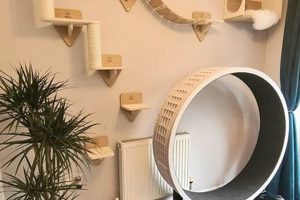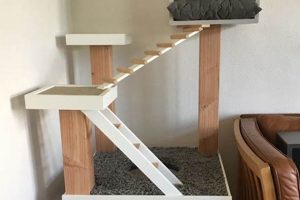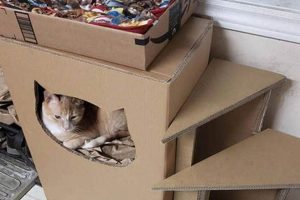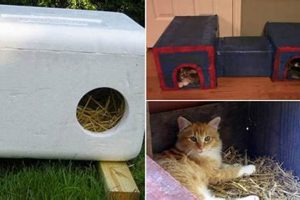A self-constructed feline refuge is designed to protect outdoor or stray cats from inclement weather conditions. These structures are typically built from readily available and inexpensive materials, providing insulation and protection from rain, snow, and extreme temperatures. Examples include shelters crafted from plastic storage bins lined with straw, or repurposed wooden pallets enclosed with insulating foam.
The creation of these feline havens is important because it directly addresses the welfare of vulnerable animals. Providing shelter significantly reduces the risk of hypothermia, frostbite, and other cold-weather ailments. Historically, concerned individuals and animal welfare organizations have promoted such initiatives to mitigate the suffering of unowned or feral cat populations, especially during winter months. The availability of effective outdoor protection greatly enhances the survival rate and overall well-being of these animals.
The following sections will delve into various design considerations, material selection, and construction techniques to guide individuals in building effective, durable, and safe outdoor housing for felines. Emphasis will be placed on readily sourced and cost-effective options, promoting widespread accessibility to this beneficial practice.
Construction Advice for Feline Outdoor Habitats
The subsequent guidance provides recommendations for the successful creation of protective outdoor structures for cats, focusing on durability, safety, and cost-effectiveness.
Tip 1: Prioritize Insulation: Effective insulation is paramount. Utilize materials such as straw (not hay), rigid foam insulation boards, or thermal blankets to minimize heat loss within the structure. The greater the thermal resistance, the warmer the interior environment.
Tip 2: Choose Weather-Resistant Materials: Exterior materials should be capable of withstanding exposure to rain, snow, and wind. Durable plastics, sealed wood, or repurposed containers designed for outdoor use are appropriate choices. Seal seams and joints to prevent water infiltration.
Tip 3: Design an Elevated Entrance: An entrance raised several inches above ground level prevents flooding from rainwater or snowmelt. A small overhang above the entrance further protects against precipitation.
Tip 4: Ensure Adequate Ventilation: While insulation is crucial, proper ventilation prevents the buildup of condensation and moisture. Small ventilation holes, strategically placed, promote airflow without compromising warmth.
Tip 5: Provide a Single, Small Entrance: Limiting the entrance size minimizes heat loss and deters larger animals from entering. A small, circular or rectangular opening is generally sufficient for feline access.
Tip 6: Consider Camouflage or Discreet Placement: Place the structure in a sheltered location, away from direct wind and heavy foot traffic. Camouflage the exterior with natural elements to minimize visibility and potential disturbance.
Tip 7: Regularly Monitor and Maintain: Periodically inspect the shelter for damage, moisture buildup, or pest infestations. Replace bedding as needed to maintain a clean and dry environment.
Implementing these suggestions will contribute to the construction of robust and effective outdoor refuges, significantly improving the well-being of the cats utilizing them. By focusing on insulation, weather resistance, and strategic design, one can create a sanctuary that offers protection from the elements.
The concluding section will address safety precautions and ongoing maintenance considerations for these protective structures.
1. Insulation
Insulation constitutes a critical element in the design and construction of a “diy cat shelter”. Its primary function is to mitigate heat loss, thereby maintaining a warmer interior environment for the inhabiting feline, particularly during periods of cold weather. The efficacy of insulation directly influences the shelter’s ability to protect against hypothermia and frostbite. For example, a shelter constructed without adequate insulation, such as a simple cardboard box exposed to sub-freezing temperatures, offers minimal protection and is unlikely to prevent significant heat loss. Conversely, a shelter lined with several inches of straw provides substantially better thermal resistance, trapping the cat’s body heat and creating a more comfortable and potentially life-saving environment. The choice and implementation of insulating materials thus serve as a direct determinant of the refuge’s effectiveness.
Practical application of insulation principles involves selecting appropriate materials and employing correct installation techniques. Straw, owing to its ability to trap air pockets, is a commonly used and effective option. Rigid foam insulation, cut to fit the interior dimensions of the shelter, offers superior thermal performance. Care must be taken to ensure that the chosen insulation material is non-toxic and does not pose a choking hazard to the animal. Furthermore, the insulation must be protected from moisture, as damp insulation loses its thermal properties. This can be achieved through the use of a waterproof outer layer or by elevating the shelter off the ground. The effectiveness of insulation can also be enhanced by minimizing the shelter’s interior volume, thereby reducing the space that needs to be heated by the cat’s body.
In summary, insulation forms an indispensable component of a functional outdoor feline shelter. Proper selection, installation, and maintenance of insulating materials directly influence the shelter’s thermal performance and the animal’s well-being. Challenges associated with maintaining dry insulation and ensuring material safety can be addressed through careful design and regular monitoring. The integration of effective insulation strategies is essential for providing a safe and protective environment for outdoor cats. Without it, the very purpose of the refuge is compromised.
2. Weatherproofing
Weatherproofing constitutes a fundamental aspect of any “diy cat shelter,” influencing its long-term effectiveness and the well-being of its occupant. Protecting the shelter from the elements is paramount to ensuring a dry, safe, and thermally stable environment for the animal.
- Material Selection for Moisture Resistance
The choice of materials plays a pivotal role in weatherproofing. Impermeable materials like durable plastics or treated wood resist water penetration. Using salvaged wood necessitates thorough sealing with weather-resistant paints or coatings to prevent rot and water damage. Selecting appropriate materials at the outset reduces the need for frequent repairs and prolongs the shelter’s lifespan. For instance, untreated cardboard offers negligible weather protection and rapidly deteriorates, whereas a plastic storage bin provides a robust, waterproof barrier.
- Sealing and Construction Techniques
Proper construction techniques are equally important. Seams and joints represent vulnerable points for water ingress. The application of silicone caulk or weather-stripping to seal these areas effectively prevents moisture from entering the shelter. Overlapping construction methods, such as creating an overhang above the entrance, deflect rainwater away from the interior. A poorly sealed shelter compromises insulation and creates a damp, uncomfortable environment conducive to mold growth, negatively impacting the animal’s health.
- Roof Design for Water Runoff
The design of the roof significantly impacts water management. A sloped roof facilitates efficient water runoff, preventing pooling and potential leaks. Flat roofs, conversely, are prone to water accumulation and require robust waterproofing measures. Overhanging eaves provide additional protection by diverting rainwater away from the shelter walls. Thoughtful roof design minimizes the risk of water damage and contributes to a drier, more stable interior environment.
- Elevated Base for Flood Protection
Raising the shelter off the ground offers crucial protection against flooding. An elevated base, constructed from bricks, wooden pallets, or similar materials, prevents water from seeping into the shelter during periods of heavy rain or snowmelt. This measure is particularly important in areas prone to flooding or where the ground becomes saturated easily. An elevated base ensures that the interior remains dry, even under adverse weather conditions, enhancing the overall comfort and safety of the shelter.
These facets collectively highlight the importance of weatherproofing in “diy cat shelter” construction. By prioritizing material selection, employing effective sealing techniques, designing for water runoff, and providing an elevated base, individuals can create durable and protective outdoor refuges that safeguard feline occupants from the detrimental effects of inclement weather. Neglecting these considerations compromises the shelter’s integrity and diminishes its capacity to provide a safe and comfortable haven.
3. Entrance Size
Entrance size represents a critical design parameter in the construction of any self-made feline shelter. Its dimensions directly influence the refuge’s ability to provide both protection from the elements and security from larger animals, impacting the overall effectiveness of the structure.
- Minimizing Heat Loss
A smaller entrance reduces the surface area through which heat can escape, improving the shelter’s thermal efficiency. In cold climates, a large opening allows significant heat dissipation, diminishing the benefits of insulation. A compact entrance retains warmth generated by the cat’s body, maintaining a more comfortable internal temperature. As an example, a shelter with a 6-inch diameter entrance will conserve heat more effectively than one with a 12-inch opening, given comparable insulation.
- Deterring Larger Animals
A strategically sized entrance restricts access to larger animals, such as dogs, raccoons, or opossums, which may pose a threat to the cat or consume its food. A small opening serves as a physical barrier, preventing larger creatures from entering the shelter and potentially causing harm. For instance, an entrance just large enough for a cat to pass through comfortably effectively excludes most larger animals. Consider using dual entrance for cats to escape easily if they feel threatened.
- Balancing Accessibility and Security
Determining the appropriate entrance size requires a balance between providing easy access for the intended feline occupant and ensuring adequate security. An excessively small opening may deter the cat from using the shelter, while an overly large opening compromises its protective function. Observation of typical feline body dimensions aids in determining the optimal size. An entrance approximately 6 to 8 inches in diameter or width is generally sufficient for most domestic cats.
- Adaptation to Local Climate and Wildlife
Entrance size adjustments should account for local climatic conditions and the presence of specific wildlife. In regions with harsh winters, minimizing the entrance size becomes particularly crucial for heat retention. Conversely, in areas with a high prevalence of predators, prioritizing a smaller entrance for enhanced security takes precedence. Tailoring the entrance size to the specific environmental context maximizes the shelter’s effectiveness.
In conclusion, the dimensions of the entrance significantly contribute to the functionality of a self-constructed feline shelter. The entrance design should optimize heat retention, deter unwanted visitors, and facilitate accessibility for the intended occupant, while adapting to the unique challenges presented by the local environment.
4. Ventilation
Ventilation, though often overlooked, is a critical element in the design and construction of a self-made feline shelter. While insulation primarily addresses heat retention, ventilation plays a crucial role in maintaining air quality and preventing moisture buildup within the enclosed space, directly impacting the health and comfort of the occupant.
- Moisture Control
The primary function of ventilation within a feline shelter is to mitigate the accumulation of moisture. Cats, like all mammals, exhale moisture, which can condense on the interior surfaces of the shelter, particularly in cold weather. Damp conditions promote the growth of mold and mildew, creating an unhealthy environment. Strategically placed ventilation openings allow for the circulation of air, reducing humidity levels and preventing condensation. For example, shelters lacking ventilation often exhibit damp bedding and visible mold growth on interior walls, whereas properly ventilated shelters remain dry and free from fungal contamination.
- Odor Management
Ventilation also aids in the removal of odors that may accumulate within the shelter. Feline urine and feces produce ammonia and other volatile organic compounds, which can create an unpleasant and potentially harmful environment. Proper airflow dilutes these odors, improving air quality and reducing the risk of respiratory irritation. Enclosed shelters with limited ventilation are prone to developing strong, lingering odors, potentially deterring the cat from using the structure.
- Temperature Regulation
While insulation primarily controls heat loss, ventilation can contribute to temperature regulation, particularly during warmer periods. Strategically positioned ventilation openings allow for the release of excess heat, preventing the shelter from becoming excessively warm in direct sunlight. In summer months, a shelter without adequate ventilation can quickly overheat, posing a risk of heatstroke to the occupant. Controlled airflow helps maintain a more stable and comfortable temperature range.
- Design Considerations for Effective Airflow
Effective ventilation does not require large or numerous openings that compromise insulation. Small, strategically placed ventilation holes, typically near the roof or upper portions of the walls, facilitate airflow without significantly increasing heat loss. The size and placement of ventilation openings should be balanced with the need for insulation, taking into account local climate conditions. For example, shelters in colder climates may require smaller ventilation openings than those in warmer regions.
The integration of appropriate ventilation strategies is essential for ensuring the long-term health and comfort of felines utilizing self-constructed shelters. By effectively managing moisture, odors, and temperature, ventilation contributes to a cleaner, safer, and more habitable environment. Neglecting this aspect can compromise the shelter’s functionality and potentially endanger the well-being of its occupant.
5. Material Safety
Material safety is paramount in the construction of a do-it-yourself feline shelter due to the direct and prolonged contact the animal will have with the structure and its components. The selection of inappropriate materials can have detrimental consequences for the cat’s health, ranging from mild irritation to severe toxicity. A shelter crafted from treated lumber, for example, may expose the animal to harmful chemicals used in the wood preservation process, potentially leading to skin irritation, respiratory problems, or even long-term health complications. Similarly, the use of lead-based paint on the shelter’s exterior poses a significant risk if ingested, resulting in lead poisoning. Therefore, a comprehensive understanding of material properties and potential hazards is essential for ensuring the safety and well-being of the feline occupant.
The practical implications of prioritizing material safety extend beyond the initial construction phase. Ongoing maintenance and repair efforts must also adhere to strict safety guidelines. When replacing damaged components or applying sealant to weatherproof the structure, non-toxic alternatives should be consistently chosen. The use of products labeled as “pet-safe” or “VOC-free” minimizes the risk of exposure to harmful chemicals. Furthermore, any sharp edges, protruding nails, or loose components should be promptly addressed to prevent injuries. Regular inspections of the shelter are crucial for identifying and mitigating potential hazards, ensuring a consistently safe environment for the animal.
In summary, material safety is an indispensable consideration in the creation and upkeep of a “diy cat shelter.” The selection of non-toxic, durable materials, coupled with meticulous construction and maintenance practices, safeguards the animal from potential harm. By prioritizing material safety, builders can create a functional and safe haven, demonstrating a commitment to responsible animal care. The failure to address this critical aspect compromises the shelter’s primary purpose, transforming a potentially beneficial structure into a source of danger.
6. Location
The placement of a self-constructed feline shelter significantly impacts its functionality and effectiveness. Selecting an appropriate location is not merely a matter of convenience; it directly influences the shelter’s ability to provide protection from the elements, security from predators, and overall accessibility for the intended feline occupant. A shelter positioned in a high-traffic area, for instance, is unlikely to be used by the cat, regardless of its construction quality. Conversely, a shelter placed in a secluded, protected spot offers a greater likelihood of acceptance and utilization, thereby fulfilling its intended purpose. Therefore, location serves as a critical, often overlooked, component of successful “diy cat shelter” deployment.
Specific environmental factors must be considered when determining the optimal location. Shelters should be situated away from direct wind exposure to minimize heat loss during cold weather. Positioning the shelter beneath an overhang or against a building wall provides additional protection from rain and snow. Elevated locations mitigate the risk of flooding during heavy precipitation. Furthermore, proximity to a food source and a clear escape route can increase the cat’s sense of security and encourage its use of the shelter. For example, a shelter placed near a regularly replenished feeding station, shielded from prevailing winds, and adjacent to a fence line offering a quick escape path, maximizes its appeal and utility for the animal.
In conclusion, the strategic placement of a self-constructed feline refuge represents a fundamental determinant of its overall effectiveness. Careful consideration of environmental factors, security concerns, and accessibility issues is essential for maximizing the shelter’s value and ensuring its utilization by the intended recipient. Challenges may arise in urban environments with limited space or in areas with high predator activity, requiring innovative solutions and adaptive placement strategies. Nevertheless, prioritizing location remains a critical aspect of responsible feline care through the provision of appropriate outdoor sheltering.
Frequently Asked Questions
The following addresses common queries regarding the construction and deployment of self-made feline shelters, focusing on providing practical information and clarifying potential misconceptions.
Question 1: What materials are most suitable for construction?
Durable plastics, sealed wood, and repurposed containers offer effective weather protection. Insulation materials such as straw or rigid foam minimize heat loss. All materials should be non-toxic and free from sharp edges or potential hazards.
Question 2: How large should the entrance be?
An entrance approximately 6 to 8 inches in diameter or width is generally sufficient for most domestic cats. The size should balance accessibility with the need to deter larger animals and minimize heat loss.
Question 3: Is ventilation necessary?
Yes, ventilation is crucial for preventing moisture buildup and maintaining air quality within the shelter. Small ventilation holes, strategically placed, promote airflow without compromising insulation.
Question 4: Where is the optimal location for placement?
The shelter should be placed in a sheltered location, away from direct wind and heavy foot traffic. Proximity to a food source and a clear escape route can enhance its utilization.
Question 5: How often should the shelter be cleaned?
Regular monitoring and maintenance are essential. The shelter should be inspected periodically for damage, moisture buildup, or pest infestations. Bedding should be replaced as needed to maintain a clean and dry environment.
Question 6: What are the primary safety concerns?
Material safety is paramount. Non-toxic materials should be used throughout the construction process. Sharp edges, protruding nails, and loose components should be promptly addressed to prevent injuries.
Effective construction and placement of these shelters require careful consideration of various factors to ensure a safe and functional environment.
The subsequent section will explore advanced design considerations for specialized shelters tailored to unique environmental conditions.
Conclusion
This exploration of “diy cat shelter” construction has underscored the importance of thoughtful design, material selection, and strategic placement in creating effective outdoor refuges for felines. Key considerations encompass insulation, weatherproofing, ventilation, entrance size, material safety, and location, each playing a critical role in the shelter’s ability to provide warmth, protection, and security.
The information presented serves as a practical guide for individuals and organizations seeking to improve the welfare of outdoor cats. The provision of safe and comfortable shelters not only enhances the well-being of these animals but also contributes to responsible community stewardship. Continued awareness and adoption of these practices are essential for mitigating the challenges faced by vulnerable feline populations in diverse environments.







